
Silene is a genus of flowering plants in the family Caryophyllaceae. Containing nearly 900 species, it is the largest genus in the family. Common names include campion and catchfly. Many Silene species are widely distributed, particularly in the northern hemisphere.

Caryophyllaceae, commonly called the pink family or carnation family, is a family of flowering plants. It is included in the dicotyledon order Caryophyllales in the APG III system, alongside 33 other families, including Amaranthaceae, Cactaceae, and Polygonaceae. It is a large family, with 81 genera and about 2,625 known species.

The Noctuidae, commonly known as owlet moths, cutworms or armyworms, are the most controversial family in the superfamily Noctuoidea because many of the clades are constantly changing, along with the other families of the Noctuoidea. It was considered the largest family in Lepidoptera for a long time, but after regrouping Lymantriinae, Catocalinae and Calpinae within the family Erebidae, the latter holds this title now. Currently, Noctuidae is the second largest family in Noctuoidea, with about 1,089 genera and 11,772 species. However, this classification is still contingent, as more changes continue to appear between Noctuidae and Erebidae.
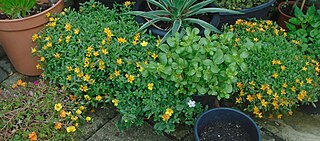
The Portulacaceae are a family of flowering plants, comprising 115 species in a single genus Portulaca. Formerly some 20 genera with about 500 species, were placed there, but it is now restricted to encompass only one genus, the other genera being placed elsewhere. The family has been recognised by most taxonomists, and is also known as the purslane family. It has a cosmopolitan distribution, with the highest diversity in semiarid regions of the Southern Hemisphere in Africa, Australia, and South America, but with a few species also extending north into Arctic regions. The family is very similar to the Caryophyllaceae, differing in the calyx, which has only two sepals.

Gypsophila is a genus of flowering plants in the carnation family, Caryophyllaceae. They are native to Eurasia, Africa, Australia, and the Pacific Islands. Turkey has a particularly high diversity of Gypsophila taxa, with about 35 endemic species. Some Gypsophila are introduced species in other regions.
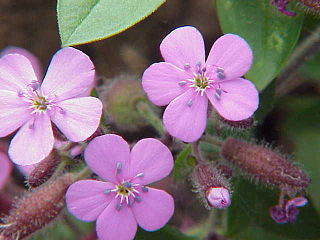
Saponaria is a genus of flowering plants in the family Caryophyllaceae. They are native to Europe and Asia, and are commonly known as soapworts.

Minuartia is a genus of flowering plants commonly known as sandworts in the family Caryophyllaceae.

Molluginaceae are a family of flowering plants recognized by several taxonomists. It was previously included in the larger family Aizoaceae. The APG III system of 2009 made no change in the status of the family as compared to the APG II system of 2003 and the APG system of 1998, apart from a reassignment of several genera, such as the placement of Corrigiola and Telephium into Caryophyllaceae, Corbichonia in Lophiocarpaceae, Microtea into Microteaceae and Limeum in Limeaceae, because the family was found to be widely polyphyletic in Caryophyllales. In addition Macarthuria was found not to be related to Limeum as previously thought and thus it was placed in Macarthuriaceae, and similarly species formerly placed in Hypertelis, apart from type species Hypertelis spergulacea, a true Molluginaceae, were found to belong elsewhere and were described as Kewa in the family Kewaceae, named for the Royal Botanic Gardens Kew. Molluginaceae is still assigned to the order Caryophyllales in the clade core eudicots, although the generic circumscription is difficult because Mollugo is not monophyletic.
Moehringia fontqueri or Arenaria funiculata is a species of plant in the family Caryophyllaceae. It is endemic to Spain. Its natural habitat is rocky areas. It is threatened by habitat loss.

Moehringia is a genus of flowering plants in the family Caryophyllaceae. Members of this genus and of some other genera in Caryophyllaceae are commonly called sandworts.They are found only in the north temperate zone. The genus Moehringia was first formally named by Carl Linnaeus in 1753. It is named after Paul Möhring (1710–1791).

Caryophyllales is a diverse and heterogeneous order of flowering plants that includes the cacti, carnations, amaranths, ice plants, beets, and many carnivorous plants. Many members are succulent, having fleshy stems or leaves. The betalain pigments are unique in plants of this order and occur in all its families with the exception of Caryophyllaceae and Molluginaceae.

Perizoma hydrata is a species of moth of the family Geometridae. It is found from most of Europe and the Caucasus through western Siberia to the Sayan Mountains and Altai and northern Mongolia.
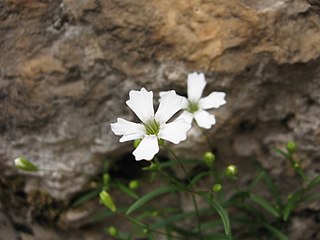
Heliosperma is a genus of flowering plants in the family Caryophyllaceae. As such, it is closely related to the large genus Silene, but its members can be told apart from Silene by the crest of long papillae on the seeds. The majority of the species are narrow endemics from the Balkan Peninsula, but H. alpestre is endemic to the Eastern Alps, and H. pusillum is found from the Cordillera Cantábrica in northern Spain to the Carpathians. Like members of the genus Silene and other related genera, Heliosperma is attacked by species of the anther smut fungus Microbotryum. Cases of parallel divergence events between alpine and mountain populations have been reported in this genus.
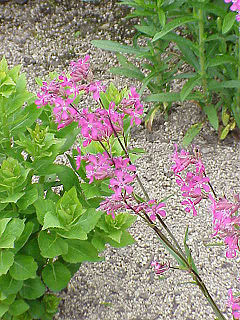
Viscaria vulgaris, the sticky catchfly or clammy campion, is a flowering plant in the family Caryophyllaceae.

Illecebrum is a monotypic genus in the family Caryophyllaceae. It contains the single species Illecebrum verticillatum, which is a trailing annual plant native to Europe, with whorls of small white flowers borne in the axils of the paired leaves.
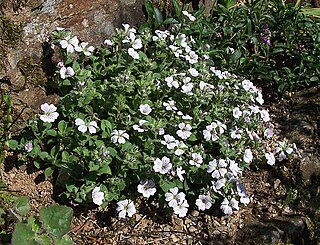
Acanthophyllum cerastioides, the chickweed baby's-breath, is a perennial plant of the family Caryophyllaceae, found in Bangladesh, Bhutan, North India, Nepal, North Pakistan and Sikkim, with a typical height of 10–27 cm. Recent molecular studies show this species is a member of genus Acanthophyllum rather than Gypsophila.

Sempervivoideae is the largest of three subfamilies in the Saxifragales family Crassulaceae, with about 20–30 genera with succulent leaves. Unlike the two smaller subfamilies, it is distributed in temperate climates. The largest genus in this subfamily is Sedum, with about 470 species.
Telephium are a genus of flowering plants in the family Molluginaceae or Caryophyllaceae, found in Mediterranean parts of Europe, Africa, the Arabian Peninsula, and western Asia. They are annual or perennial herbs, sometimes becoming woody at their bases. Together with Corrigiola they form the tribe Corrigioleae.
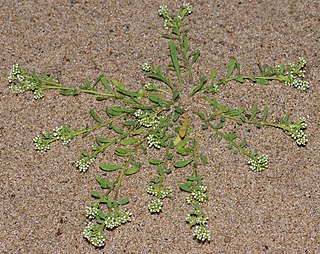
Corrigiola, the strapworts, are a genus of flowering plants in the family Caryophyllaceae, with a highly disjunct distribution in Mexico, South America, southern and eastern Africa, Madagascar, northwestern Africa, Europe and western Asia. Together with Telephium they form the tribe Corrigioleae.
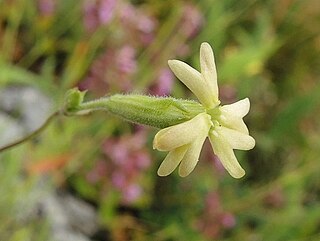
Silene flavescens are flowering plants part of the genus Silene, family Caryophyllaceae. They are widely distributed and are found in the northern hemisphere. They are native to Hungary and the Balkan Peninsula. It is an herbaceous species belonging to the tribe Sileneae


















